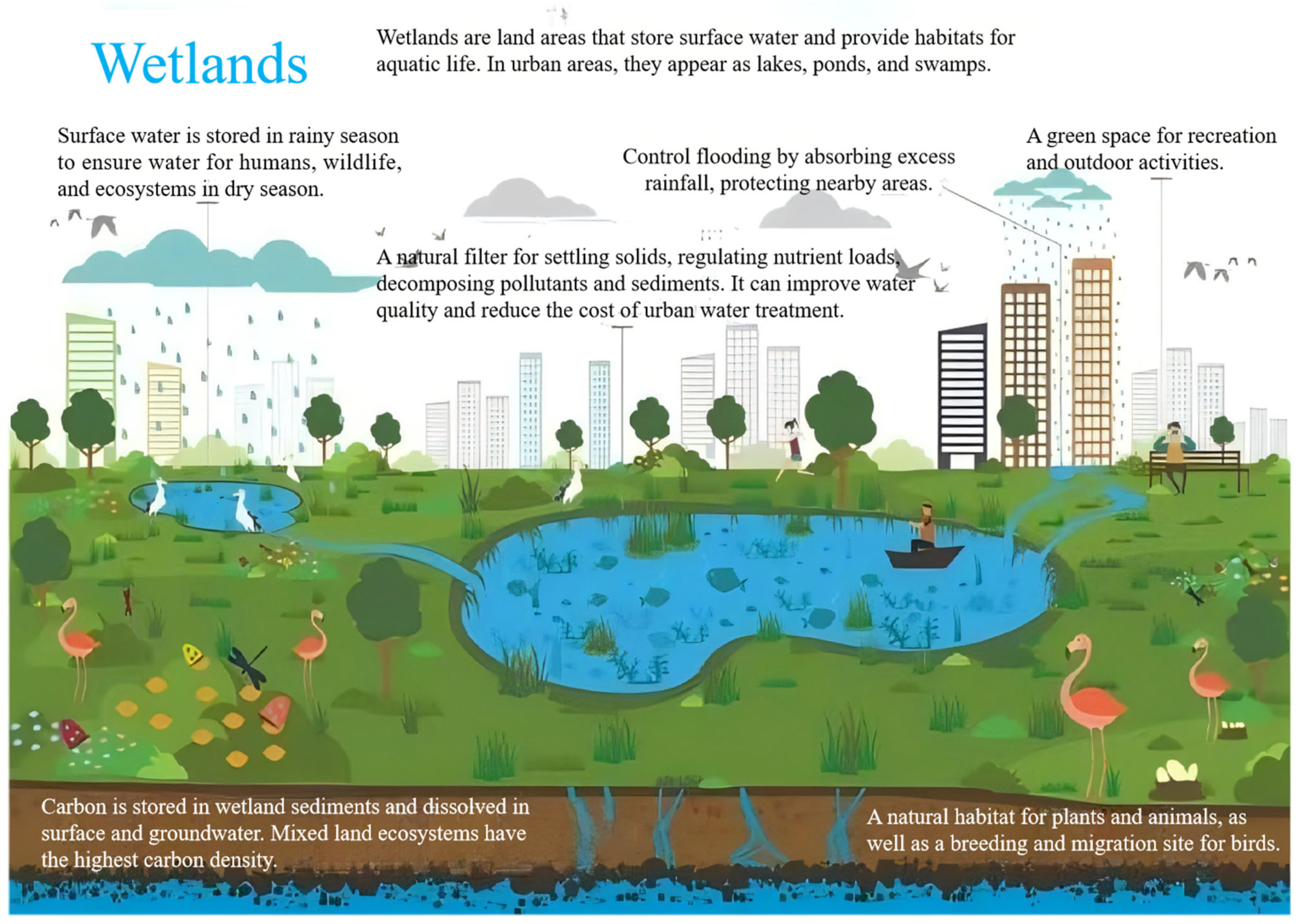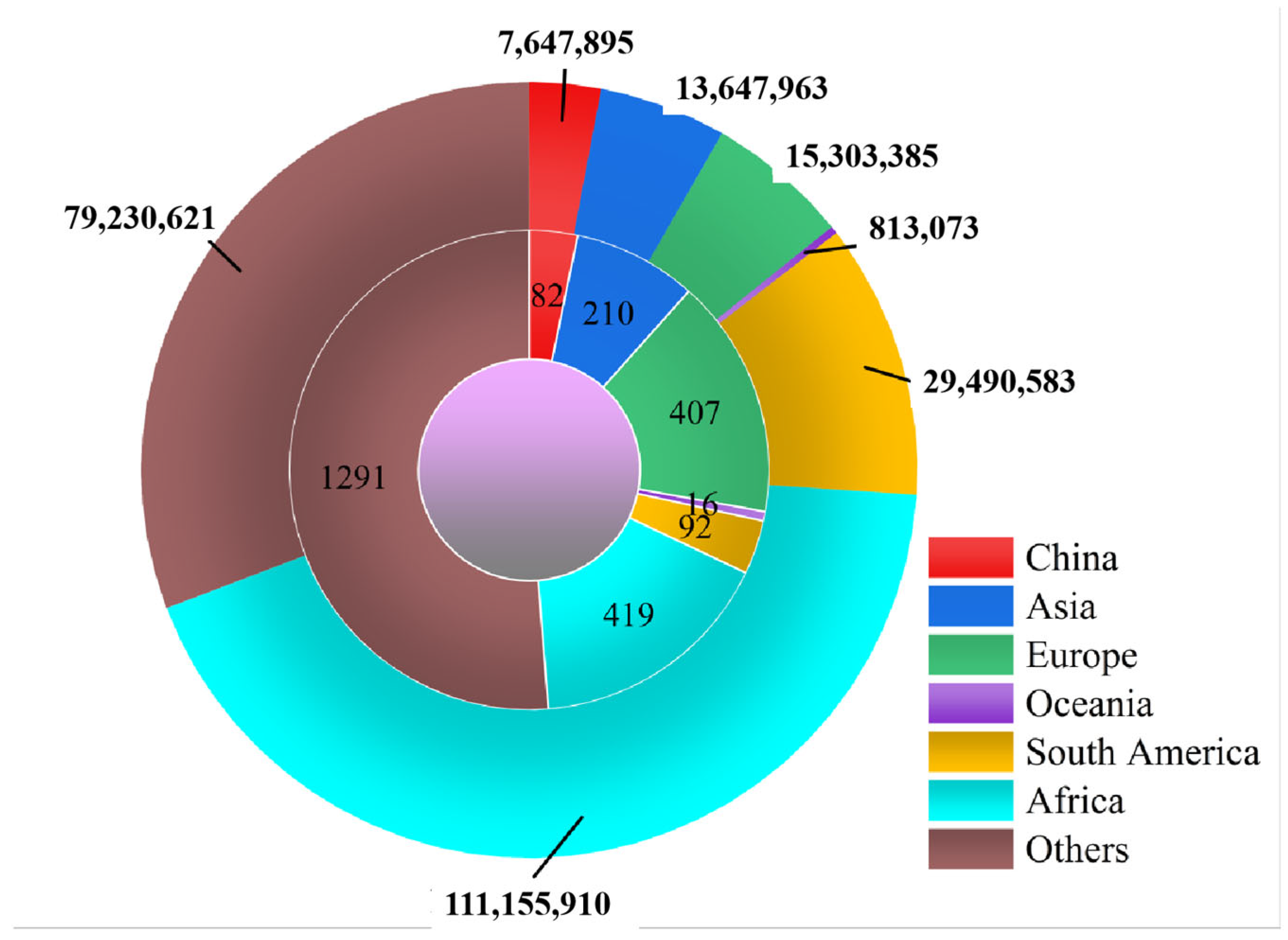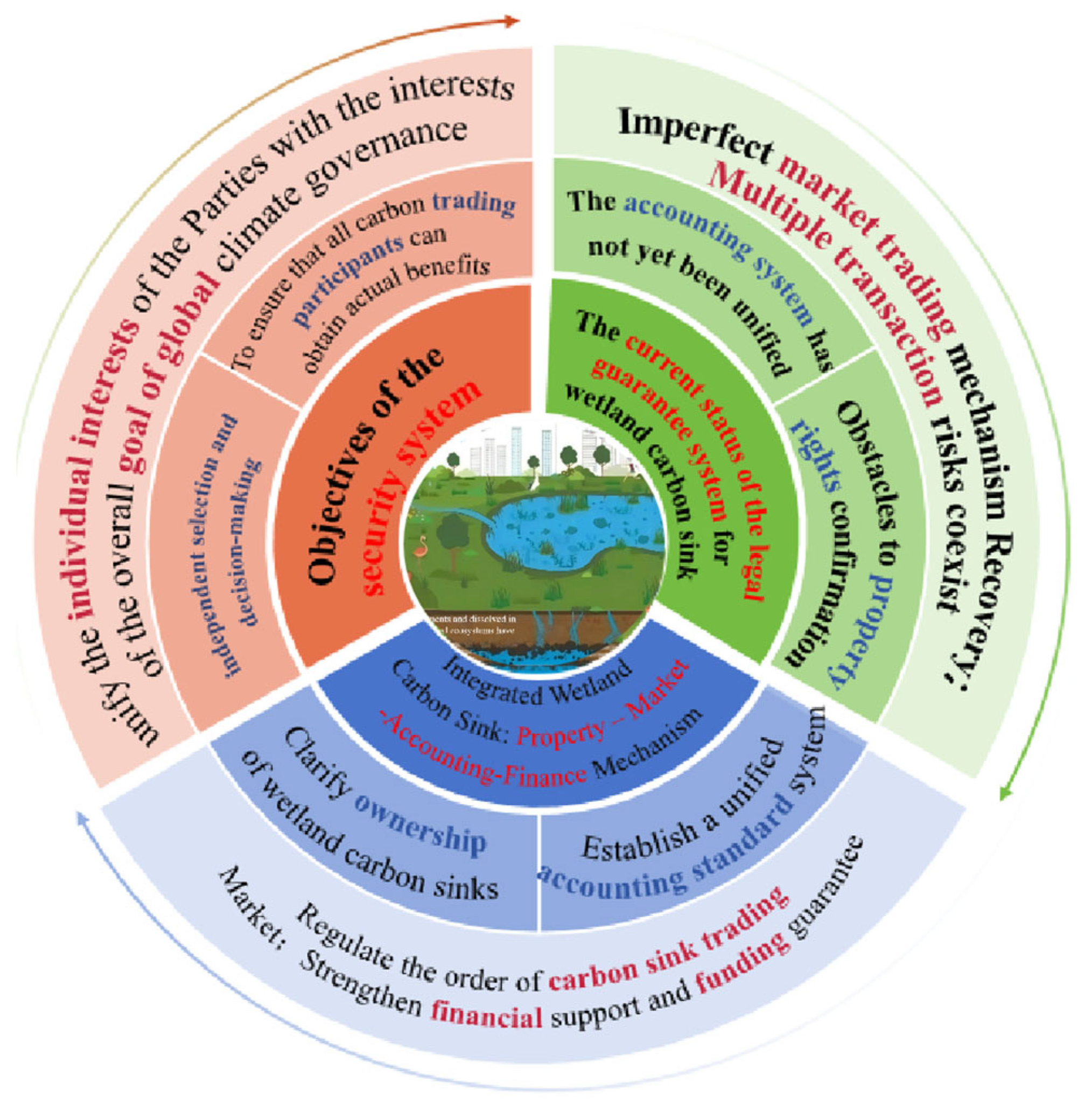Comprehensive Overview Assessment on Legal Guarantee System of Wetland Carbon Sink Trading for One Belt and One Road Initiative
Abstract
1. Introduction
2. Research Design and Methods
2.1. Policy Analysis Method
2.2. Desk Research
3. Historical Overview of Wetland and Carbon Policy
4. Practical Investigation of Wetland Carbon Sink Trading Along the Belt and Road Initiative
4.1. Carbon Trading Is an Important Part of Green “Belt and Road” Construction and International Cooperation
4.2. Overview of Wetlands in Countries Along the Belt and Road
5. Theoretical Framework of Institutional Supply of Wetland Carbon Sink Trading Along the Belt and Road Initiative
5.1. Wetland Carbon Sink Property Rights System
5.1.1. Determination of the Legal Attributes of Wetland Carbon Sink Property Rights
5.1.2. Rules for Defining Wetland Carbon Sink Property Rights
5.2. Wetland Carbon Sequestration Market Rules
5.2.1. Wetland Carbon Sink Trading Market Players
5.2.2. Price Rules for Wetland Carbon Sink Trading
5.3. Wetland Carbon Sequestration Supervision and Institutional Guarantee
5.3.1. Wetland Carbon Sink Trading Should Comply with the Equator Principles
5.3.2. Wetland Carbon Sinks Should Be Developed in Coordination with Biodiversity Conservation Goals
6. Suggestions on Establishing a Legal Guarantee System for Wetland Carbon Sink Trading Along the Belt and Road
6.1. The Current Status of the Legal Guarantee System for Wetland Carbon Sink Trading for the Belt and Road Initiative
6.1.1. Obstacles to Property Rights Confirmation
6.1.2. The Accounting System Has Not Yet Been Unified
6.1.3. Imperfect Market Trading Mechanism
6.1.4. Multiple Transaction Risks Coexist
6.2. Suggestions on Improving the Legal Guarantee System for Wetland Carbon Sink Trading Along the Belt and Road
6.2.1. Objectives of the Security System
6.2.2. Specific Rule Design
7. Conclusions
Author Contributions
Funding
Data Availability Statement
Conflicts of Interest
References
- Kikstra, J.S.; Nicholls, Z.R.J.; Smith, C.J.; Lewis, J.; Lamboll, R.D.; Byers, E.; Sandstad, M.; Meinshausen, M.; Gidden, M.J.; Rogelj, J.; et al. The IPCC Sixth Assessment Report WGIII climate assessment of mitigation pathways: From emissions to global temperatures. Geosci. Model Dev. 2022, 15, 9075–9109. [Google Scholar] [CrossRef]
- Weston, N.B.; Neubauer, S.C.; Velinsky, D.J.; Vile, M.A. Net ecosystem carbon exchange and the greenhouse gas balance of tidal marshes along an estuarine salinity gradient. Biogeochemistry 2014, 120, 163–189. [Google Scholar] [CrossRef]
- Pang, S.; Abdul Majid, M.; Perera, H.A.C.C.; Sarkar, M.S.I.; Ning, J.; Zhai, W.; Guo, R.; Deng, Y.; Zhang, H. A Systematic Review and Global Trends on Blue Carbon and Sustainable Development: A Bibliometric Study from 2012 to 2023. Sustainability 2024, 16, 2473. [Google Scholar] [CrossRef]
- Ribeiro, K.; Pacheco, F.S.; Ferreira, J.W.; de Sousa-Neto, E.R.; Hastie, A.; Filho, G.C.K.; Alvalá, P.C.; Forti, M.C.; Ometto, J.P. Tropical peatlands and their contribution to the global carbon cycle and climate change. Glob. Change Biol. 2020, 27, 489–505. [Google Scholar] [CrossRef]
- Whiting, G.J.; Chanton, J. Greenhouse carbon balance of wetlands: Methane emission versus carbon sequestration. Tellus B Chem. Phys. Meteorol. 2016, 53, 521–528. [Google Scholar] [CrossRef]
- Craft, C. Creating and restoring wetlands: From theory to practice. Choice Rev. Online 2016, 53, 53–5237. [Google Scholar] [CrossRef]
- Guan, Y.; Tian, X.; Bai, J.; Zhou, H.; Wen, L. Assessing the carbon neutrality capacity of wetland and non-wetland ecosystems in a typical coastal region. Sustain. Prod. Consum. 2025, 53, 17–27. [Google Scholar] [CrossRef]
- Xie, Y. Carbon Sequestration Potential of Wetland Parks: A Case Study of Guangzhou Wetland Park. Meteorol. Environ. Res. 2024, 15, 52–55. [Google Scholar]
- Zhao, X.; Ma, X.; Chen, B.; Shang, Y.; Song, M. Challenges toward carbon neutrality in China: Strategies and countermeasures. Resour. Conserv. Recycl. 2022, 176, 105959. [Google Scholar] [CrossRef]
- Ziyue, W. The Impact of the Carbon Border Adjustment Mechanism (CBAM) on China’s New Energy Vehicle Exports to the European Union. J. Econ. Manag. Sci. 2025, 8, 44. [Google Scholar] [CrossRef]
- Convention on Wetlands of International Importance especially as Waterfowl Habitat. Available online: https://www.ramsar.org/sites/default/files/documents/library/scan_certified_e.pdf (accessed on 25 July 2024).
- Lixin, L.; Xu, H.B.; Zhang, Q.; Zhan, Z.S.; Liang, X.W.; Xing, J. Estimation methods of wetland carbon sink and factors influencing wetland carbon cycle: A review. Carbon Res. 2024, ,3, 50. [Google Scholar]
- Mack, S.K.; Lane, R.R.; Cowan, R.; Cole, J.W. Status and challenges of wetlands in carbon markets. Wetl. Carbon Environ. Manag. 2021, 411–419. [Google Scholar] [CrossRef]
- Murray, B.C.; Vegh, T. Incorporating blue carbon as a mitigation action under the United Nations Framework Convention on Climate Change technical issues to address. Rep. NI 2012, 12, 5. [Google Scholar]
- Sampaio, R.S.d.R. Seeing the forest for the treaties: The evolving debates on forest and forestry activities under the clean development mechanism ten years after the Kyoto protocol. Fordham Int. Law J. 2007, 31, 634. [Google Scholar]
- Hirsch, D.D. Trading in ecosystem services: Carbon sinks and the clean development mechanism. J. Land Use Environ. Law 2007, 22, 623–639. [Google Scholar]
- Sutherland, W.J.; Atkinson, P.W.; Butchart, S.H.M.; Capaja, M.; Dicks, L.V.; Fleishman, E.; Gaston, K.J.; Hails, R.S.; Hughes, A.C.; Le Anstey, B.; et al. A horizon scan of global biological conservation issues for 2022. Trends Ecol. Evol. 2021, 37, 95–104. [Google Scholar] [CrossRef]
- Duarte, C.M.; Kennedy, H.; Marbà, N.; Hendriks, I. Assessing the capacity of seagrass meadows for carbon burial: Current limitations and future strategies. Ocean. Coast. Manag. 2013, 83, 32–38. [Google Scholar] [CrossRef]
- Sun, M.; Vortia, M.P.; Xiao, G.; Yang, J. Carbon Policies and Liner Speed Optimization: Comparisons of Carbon Trading and Carbon Tax Combined with the European Union Emissions Trading Scheme. J. Mar. Sci. Eng. 2025, 13, 204. [Google Scholar] [CrossRef]
- Jaramillo-Morán, M.A.; Fernández-Martínez, D.; García-García, A.; Carmona-Fernández, D. Improving Artificial Intelligence Forecasting Models Performance with Data Preprocessing: European Union Allowance Prices Case Study. Energies 2021, 14, 7845. [Google Scholar] [CrossRef]
- Large-Scale Political Documentary on the 10th Anniversary of the Belt and Road Initiative. The Boundless Path. Available online: https://news.cctv.com/2023/10/11/ARTIa03H9zKZns1WPHJwVrSA231011.shtml (accessed on 31 November 2024).
- Laihui, X. Carbon Emission as a New Source of Power? Emission Power in Global Climate Governance. World Econ. Politics 2016, 9, 64–89+157–158. [Google Scholar]
- Tan, Z.X.; Chen, D. Regional Carbon Trading Mode and Its Implementation Path. China Soft Sci. 2012, 76–84. [Google Scholar]
- Erwin, K.L. Wetlands and global climate change: The role of wetland restoration in a changing world. Wetl. Ecol. Manag. 2009, 17, 71–84. [Google Scholar] [CrossRef]
- Jakeman, A.J.; Barreteau, O.; Hunt, R.J.; Rinaudo, J.-D.; Ross, A. Integrated Groundwater Management; Springer: Berlin/Heidelberg, Germany, 2016. [Google Scholar]
- Expert Systems With Applications. Available online: https://rsis.ramsar.org/?pagetab=2 (accessed on 31 July 2024).
- Williamson, O.E.; Winter, S.G. The Nature of the Firm: Origins, Evolution, and Development; Oxford University Press: Oxford, UK, 1993. [Google Scholar]
- Coase, R.H. 3. The nature of the firm: Influence. J. Law Econ. Organ. 1988, 4, 33–47. [Google Scholar]
- Ho, P. An endogenous theory of property rights: Opening the black box of institutions. J. Peasant. Stud. 2016, 43, 1121–1144. [Google Scholar] [CrossRef]
- Musole, M. Property Rights, Transaction Costs And Institutional Change: Conceptual Framework And Literature Review. Prog. Plan. 2009, 71, 43–85. [Google Scholar] [CrossRef]
- Kennet, S.; Kwasniak, A.; Lucas, A. Property rights and the legal framework for carbon sequestration on agricultural land. Ott. Law Rev. 2005, 37, 171. [Google Scholar]
- Stewart-Sinclair, P.; Bulmer, R.; Macpherson, E.; Lundquist, C.J. Enabling coastal blue carbon in Aotearoa New Zealand: Opportunities and challenges. Front. Mar. Sci. 2024, 11, 1290107. [Google Scholar] [CrossRef]
- Crittenden, J.; Wilder, M. Bringing the Forest to Market: Structuring Avoided Deforestation Projects. Carbon Clim. Law Rev. 2008, 2, 273–280. [Google Scholar] [CrossRef]
- Li, S.J.; Di, J.Q.; Su, Y.Z. Mechanism and path of the value realization of blue carbon sink of coastal wetlands in China from the perspective of carbon sink trading. Mar. Environ. Sci. 2023, 42, 55–63. [Google Scholar]
- Allan, J.; Antonich, B.; Kantai, T.; Jones, N.; Lebădă, A.M.; Bullon-Cassis, L. IISD Reporting Services. In Proceedings of the Summary of the Chile/Madrid Climate Change Conference, Madrid, Spain, 2–15 December 2019. [Google Scholar]
- Australian Government and Queensland Government: Reef 2050 Long-Term Sustainability Plan (2018) [EB/OL]. (2018-07-01). Available online: https://www.dcceew.gov.au/parks-heritage/great-barrier-reef/publications/reef-2050-long-term-sustainability-plan-2018 (accessed on 31 September 2024).
- McLeod, E.; Shaver, E.C.; Beger, M.; Koss, J.; Grimsditch, G. Using resilience assessments to inform the management and conservation of coral reef ecosystems. J. Environ. Manag. 2021, 277, 111384. [Google Scholar] [CrossRef] [PubMed]
- Wright, C. Global Banks, the Environment, and Human Rights: The Impact of the Equator Principles on Lending Policies and Practices. Glob. Environ. Politics 2012, 12, 56–77. [Google Scholar] [CrossRef]
- Grandjean, Implications of the precautionary principle for primary prevention and research. Annu. Rev. Public Health 2004, 25, 199–223. [CrossRef] [PubMed]
- Luo, P.; Yan, P.; Wang, X.; Wu, Y.; Lyu, J.; He, B.; Duan, W.; Wang, S.; Zha, X. Historical and comparative overview of sponge campus construction and future challenges. J. Sci. Total Environ. 2023, 907, 167477. [Google Scholar] [CrossRef]
- Luo, P.; Wang, X.H.; Zhang, L.; Mohd, R.A.Z.; Duan, W.L.; Hu, M.; Guo, B.; Zhang, Y.Z.; Wang, Y.; Nove, D. Future Land Use and Flood Risk Assessment in the Guanzhong Plain, China: Scenario Analysis and the Impact of Climate Change. J. Remote Sens. 2023, 15, 5778. [Google Scholar] [CrossRef]
- Mehling, M.A. Governing Cooperative Approaches Under the Paris Agreement. Ecol. Law Q. 2019, 46, 765–828. [Google Scholar]
- Rijal, M.; Luo, P.; Mishra, K.B.; Zhou, M.M.; Wang, X.H. Global systematical and comprehensive overview of mountainous flood risk under climate change and human activities. J. Sci. Total Environ. 2024, 941, 173672. [Google Scholar] [CrossRef]




| Organizations | Documents | Contents |
|---|---|---|
| United Nations Environment Programme, Food and Agriculture Organization of the United Nations | Blue Carbon: The Role of Healthy Oceans in Binding Carbon—A Rapid Response Assessment | Carbon sink was proposed, confirming the role of the ocean in climate change and the carbon cycle. |
| Conservation International, Intergovernmental Oceanographic Commission, etc. | Blue Carbon Initiative | Establish a policy working group and a scientific working group to continue to use coastal and marine ecosystems to mitigate climate change variety. |
| Intergovernmental Oceanographic Commission, United Nations Development Programme, etc. | Blueprint for Ocean and Coastal Sustainability | It is recommended that a global carbon sink trading market, a global carbon sink fund, and unified monitoring and certification standards be established, and the proposal should include carbon sinks in the policy framework of the United Nations Framework Convention on Climate Change. |
| United Nations Intergovernmental Panel on Climate Change Door Committee | 2013 Supplement to the 2006 IPCC Guidelines for National Greenhouse Gas Inventories: Wetlands | Include coastal wetlands (including mangroves, tidal marshes, and seagrasses) in national greenhouse gas inventories. |
| Organizations | Documents | Contents |
|---|---|---|
| Former State Oceanic Administration | Opinions on the work related to addressing climate change in the marine sector | Carbon sink was proposed, confirming the ocean in climate change and the carbon cycle. |
| State Council | The 12th Five-Year Plan for the Development of the National Marine Economy | Promote the ecological restoration and protection of coastal wetlands and build ecological barriers in intertidal zones and tidal flats. |
| CPC Central Committee, State Council | Overall Plan for Ecological Civilization System Reform | Establish effective mechanisms to increase carbon sinks in forests, grasslands, wetlands, and oceans. |
| State Council | The 13th Five-Year Plan for Controlling Greenhouse Gas Emissions | Include coastal wetlands (including mangroves, tidal marshes, and seagrasses) in national greenhouse gas inventories. |
| Former State Oceanic Administration | Guiding Opinions on Strengthening the Management and Protection of Coastal Wetlands | Strengthen the protection of significant natural coastal wetlands, restore and repair damaged coastal wetland ecosystems, strictly manage the development and utilization of coastal wetlands, and strengthen coastal wetland surveys and monitoring. |
| State Oceanic Administration and Standardization Administration of China | National Marine Standardization “Thirteenth Five-Year Plan” Development Plan | In the marine ecological environment assessment subsystem, formulate standards for marine resource and environmental carrying capacity assessments, early warnings, marine carbon sinks, etc. |
| State Council | The 13th Five-Year Plan for Controlling Greenhouse Gas Emissions | Propose to explore and carry out carbon sink pilot projects in marine and other ecosystems, and launch a carbon sink pilot program in coastal and marine ecosystems |
| CPC Central Committee, State Council | Several Opinions on Improving the Strategy and System of Major Functional Areas | Explore the establishment of a blue carbon standard system and trading mechanism. |
| CPC Central Committee, State Council | Implementation Plan for the National Ecological Civilization Pilot Zone (Hainan) | Research blue carbon standard systems and trading mechanisms, and explore establishing international carbon emission trading venues per the law. |
| Area | Quantity | Quantity Ratio (%) | Area (ha) | Area Ratio (%) |
|---|---|---|---|---|
| China | 82 | 3 | 7,647,895 | 3 |
| Asia (Belt and Road countries) | 210 | 8 | 13,647,963 | 5.3 |
| Europe (One Belt One Road) | 407 | 16.17 | 15,303,385 | 5.9 |
| Oceania | 16 | 0.6 | 813,073 | 0.3 |
| South America | 92 | 3.6 | 29,490,583 | 11.46 |
| Africa | 419 | 16.64 | 111,155,910 | 43.20 |
| Others | 1291 | 51.99 | 79,230,621 | 30.84 |
| Years | Organizations | Documents | Contents |
|---|---|---|---|
| 2012 | World Forestry Research Center | Method for Measuring Carbon Sequestration in Mangroves | Applicable to afforestation and reforestation activities of degraded mangroves worldwide |
| 2012 | American Carbon Registry | Restoration of Degraded Delta Wetlands in the Mississippi Delta | Applicable only to degraded forested and non-forested wetlands in the Mississippi Delta |
| 2013 | CDM | Small-scale afforestation and reforestation project activities on wetlands | Applicable only to afforestation and reforestation projects on wetlands with an annual carbon sink of less than 16,000 tons |
| 2013 | FAO | REDD+ approach framework | Applicable to mangrove deforestation, degradation, afforestation, reforestation, and vegetation planting, planned and unplanned wetland degradation, and wetland restoration activities worldwide |
| 2014 | CER | Methodology for constructing coastal wetlands | Applicable only to wetlands degraded in open water areas within the United States |
| 2014 | IPCC | 2013 Supplement to the 2006 IPCC Guidelines for National Greenhouse Gas Inventories: Wetlands | Applicable to global coastal wetland greenhouse gas emissions and assessment |
| 2014 | United Nations Environment Programme | Coastal blue carbon: Methods for assessing carbon storage and release factors in mangroves, salt marshes and seagrass beds | Carbon sink assessment applicable to global coastal blue carbon ecosystems |
| 2015 | CER | Tidal flat wetland and seagrass restoration methodology | Applicable to degraded marshes and seagrass meadows worldwide |
| 2017 | American Carbon Registry | California Delta and Coastal Wetlands Respond | Applicable only to agricultural land and degraded tidal wetlands in the Sacramento-San Joaquin Delta, USA |
| 2020 | Shenzhen Dapeng New District | Carbon Sink Accounting Guide | Only applicable to Shenzhen Dapeng New District |
Disclaimer/Publisher’s Note: The statements, opinions and data contained in all publications are solely those of the individual author(s) and contributor(s) and not of MDPI and/or the editor(s). MDPI and/or the editor(s) disclaim responsibility for any injury to people or property resulting from any ideas, methods, instructions or products referred to in the content. |
© 2025 by the authors. Licensee MDPI, Basel, Switzerland. This article is an open access article distributed under the terms and conditions of the Creative Commons Attribution (CC BY) license (https://creativecommons.org/licenses/by/4.0/).
Share and Cite
Min, J.; Yuan, W.; He, W.; Luo, P.; Zhang, H.; Zhao, Y. Comprehensive Overview Assessment on Legal Guarantee System of Wetland Carbon Sink Trading for One Belt and One Road Initiative. Land 2025, 14, 1583. https://doi.org/10.3390/land14081583
Min J, Yuan W, He W, Luo P, Zhang H, Zhao Y. Comprehensive Overview Assessment on Legal Guarantee System of Wetland Carbon Sink Trading for One Belt and One Road Initiative. Land. 2025; 14(8):1583. https://doi.org/10.3390/land14081583
Chicago/Turabian StyleMin, Jingjing, Wanwu Yuan, Wei He, Pingping Luo, Hanming Zhang, and Yang Zhao. 2025. "Comprehensive Overview Assessment on Legal Guarantee System of Wetland Carbon Sink Trading for One Belt and One Road Initiative" Land 14, no. 8: 1583. https://doi.org/10.3390/land14081583
APA StyleMin, J., Yuan, W., He, W., Luo, P., Zhang, H., & Zhao, Y. (2025). Comprehensive Overview Assessment on Legal Guarantee System of Wetland Carbon Sink Trading for One Belt and One Road Initiative. Land, 14(8), 1583. https://doi.org/10.3390/land14081583







